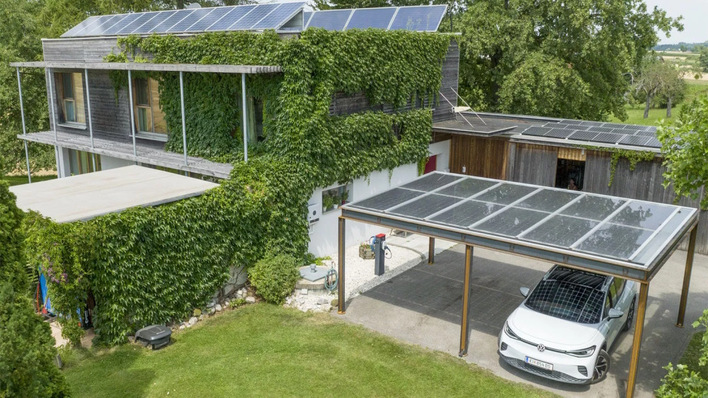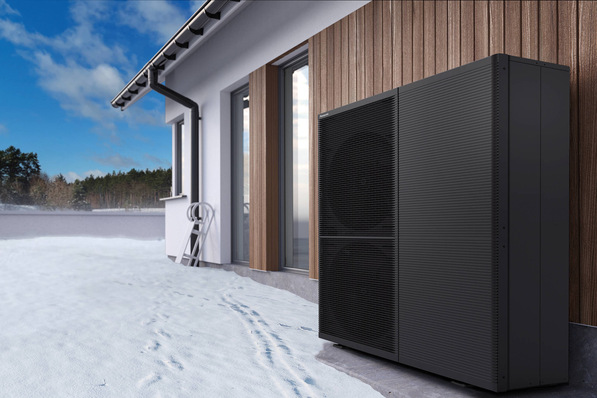A heat pump and a heating element for generating hot water: In building services for private customers, such systems are now almost considered the standard. And in the commercial sector, they are also becoming increasingly common. One of the major drivers for the solar sector is electric mobility. The age of cars driven by natural gas, petrol and diesel is practically at an end. Now, filling stations will be linked to homes or company buildings; and solar carports are helping to encourage this trend.
Almaden supports self-reliance
This year in Munich, Almaden Europe demonstrated to an impressive degree, how far integrated energy can be taken. Since the company is based in the Bavarian capitol, they were clearly at a home advantage. Their goal is to provide their customers with flexible assembly kits for more self-reliance.
Along with self-sufficiency solutions for solar carports and verandas that combine glass-glass panels with delicate aluminium profiles, Almaden Europe also build large PV power plants. All of Almaden’s products are durable and can resistant to extreme cold, water as well as high wind and snow loads.
Huawei Solar: Vision of a digital world
The activities of the Chinese electronics supplier Huawei in the solar industry are not limited to inverters and battery systems. The company also integrates digital information technology, the Internet and photovoltaics.
Fusion Home Smart Energy Center is a solar controller with an output of two to five kilowatts. It regulates the energy generation of the solar system like a string inverter, but has some interesting additions especially targeted at integrated energy: It integrates DC optimisers on the solar panels and a safety box that controls the energy flow in the building depending on load and storage capacity. Partial shading or different orientation of the panels is no longer a problem. The box disconnects the DC side of the system if required. The battery interface allows the connection of high-voltage batteries.
My-PV presents AC Thor
In 2013, the Austrian manufacturer My-PV introduced their system Elwa, a solar-powered electric water heater. Once sneered at by solar thermal advocates, it has since transpired that such PV-based systems will supersede solar thermals for private homes.
In 2015, there followed the AC version AC Elwa, which can transform surplus electricity of grid-connected PV installations into heat. The AC Elwa-E, at last brought about the break-through that turned My-PV into the leader in its field in 2016.
Now the company from Neuzeug has gone further and even produces heating based on solar PV. Their innovative new product AC Thor not only controls heating elements for hot water production, but also electric under-floor heating, infrared panels and buffer radiators. With growth rates at 80 percent per year, business has been very successful.
AC Thor and the Power Meter help to electrify all of the building services: wires instead of pipes; simple and efficient. The Power Meter assesses how much power comes from the PV array and passes on the data to the AC Thor. Surplus energy is used for generating heat (primarily hot water, secondarily heating). This maximised the rate of self-consumption – up to 85 percent even without a storage battery.
The system practically requires no maintenance and can be combined with a variety of inverters and battery systems or be integrated into a smart home system.
Phoenix Contact: Charging at 500 amperes
Phoenix Contact is a globally active company for components, systems and solutions in electrical engineering, electronics and automation. This family-run business headquartered in Blomberg in Westphalia has about 16,500 employees and in 2017 generated a turnover of 2.2 billion euros.
At the trade fair in Munich, Phoenix Contact presented their high-performance charge point High Power Charging (HPC), which can charge an EV battery at 500 kilowatts, charging 100 kilometres of range in three to five minutes. The system includes a cleverly cooled high-power charging plug, a cooled charging cable, cable feed-through with defined interfaces and a cooling unit. It allows charging at up to 500 amps. At a system voltage of 1,000 volts, this produces a charging current of 500 kilowatts.
This efficient and environmentally friendly cooling system permits smaller cable cross-sections. The system is constantly monitored for temperature and leakages. Thanks to easily replaceable components and the fact that the cooling system is semi-open, it is very low-maintenance. It also is fully compatible with the well-established Combined Charging System (CCS).
Phoenix Contact has been setting standards in EV charging for a while now. Be it charging from an AC grid or fast DC charging: AC and DC charging plugs and sockets are safe, reliable and user-friendly. Their use is in accordance with the industry standards for type 1, type 2 and GB/T charging technology. The surfaces of both the transmission and signal contacts are silver-plated. All the EV-plugs and the charging infrastructure are designed according to a consistent deign language. Charging is made safe through both monitoring the temperature and an innovative locking mechanism.
Through the software EV Charging Suite, the company provides a smart interface between driver, charger or grid operator as well as billing provider. Along with the load management, it keeps track of the charging points and users, various methods of authorization and consumption-based billing.
This smart load management distributes the outputs in an ideal way and thus helps to prevent overloading. Using the web interface, commissioning, configuration and monitoring are very easy. The system can simply be scaled up by adding further charging points. All charging is also recorded and visualised in real time. Exact billing is taken care of by OCPP. The software can conveniently be integrated into higher-level building and energy management systems.
Solar-Log turns goes energy management
Solare Datensysteme is renowned for Solar-Log, the tried-and-tested data logger for the solar industries. The company based in Swabia is one of the leading providers of monitoring, smart energy and feed-in management services. Since 2007, their Solar-Log product range is being utilised in 118 countries, where it monitors 279,000 installations with a total output of 12 gigawatts. The data loggers are compatible with more than 2,300 different inverters.
In the meantime, monitoring has transformed into energy management. Integrating charging stations for EVs is becoming crucial, for instance combination with a Keba charger.
A so-called current limiter supplies the EV with a minimal amount of charge as long as no solar power is available. Once the system notices a surplus from the solar panels, the limit on charging is released.
Also of great potential for increasing self-consumption is combining photovoltaics and a heat pump: Depending on how the heat pump is integrated into the Solar-Log, the system either gives it a go-ahead or channels the surplus power into the heat pump. (Heiko Schwarzburger)
Watch our PV Guided Tour on electrical heat and e-mobility:
http://www.pveurope.eu/Videos/pv-Guided-Tours-videos-2018
Stay informed, get our newsletter twice a week. Register here
Read more about solar modules.
Read more about solar mounting systems.
Read more about solar energy storage.







